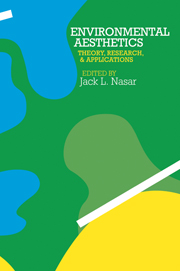Book contents
- Frontmatter
- Contents
- List of figures
- List of tables
- List of contributors and participants
- Acknowledgments
- Preface
- Section I Theory
- Section II Empirical studies
- Editor's introduction
- A Methodological comments
- Editor's introduction
- 9 The assessment of landscape quality: an integrative approach
- 10 Affective appraisals of environments
- B Architectural interiors
- C Architectural exteriors
- D Urban scenes
- E Natural and rural scenes
- Section III Applications
- References
- Index of authors
- Subject index
9 - The assessment of landscape quality: an integrative approach
Published online by Cambridge University Press: 05 September 2013
- Frontmatter
- Contents
- List of figures
- List of tables
- List of contributors and participants
- Acknowledgments
- Preface
- Section I Theory
- Section II Empirical studies
- Editor's introduction
- A Methodological comments
- Editor's introduction
- 9 The assessment of landscape quality: an integrative approach
- 10 Affective appraisals of environments
- B Architectural interiors
- C Architectural exteriors
- D Urban scenes
- E Natural and rural scenes
- Section III Applications
- References
- Index of authors
- Subject index
Summary
Landscape-preference studies and the more general research area of human response to natural environments have been plagued by a number of unresolved theoretical and methodological issues, making any general statement of findings or of theoretical synthesis problematic. Researchers adopt either atheoretical, stimulus-defined methodologies, or theoretically prescribed response measures that may or may not bear any meaningful relation to stimulus material. This splintered effort has been compounded by the differing disciplinary orientations of those doing research in this area, with human geographers and landscape architects subscribing to a largely atheoretical and apsychological approach, and psychologists opting for a theoretically derived psychometric stance. There has been no successful attempt to date to develop an approach that would allow for a meaningful and working relationship between theory and method – and, indeed, among disciplines – although a number of individuals have suggested that this is a critical prerequisite for further development in the field of environmental perception and preference (e.g., Carlson, 1977; Wohlwill, 1976; Zube, Sell, and Taylor, 1982).
Approaches to the definition and measurement of landscape
The physical environment has typically been defined either in terms that are independent of the perceiving individual (Barker, 1965; Brunswik, 1956; Wohlwill, 1973) or in terms of individual perception and construct of the environment (Boulding, 1956; Ittelson, 1976; Klausner, 1971; Wapner, Kaplan, and Cohen, 1973). Research in environmental aesthetics, for example, which most often treats the physical setting as the sole predictor of preference, defines setting variables in either objective or perceptual terms, in which objective refers to the quantification of environmental variables through a yardstick that is other than the perceptual cognitive process.
- Type
- Chapter
- Information
- Environmental AestheticsTheory, Research, and Application, pp. 108 - 119Publisher: Cambridge University PressPrint publication year: 1988
- 3
- Cited by



